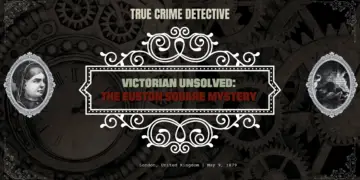
Laetitia Toureaux: The Impossible Murder on the Paris Métro
1930s Paris was one of the truly great eras in the history of France’s City of Light. A centre for art and bohemian culture as it always was, the city was home to the new waves of culture sweeping the world across the realms of fashion and cinema. Coco Chanel was just as likely to be found dominating the press as either Picasso or Dalí. Yet, this atmosphere was tempered by the political tensions that go hand-in-hand with life in the French capital, with the spectre of fascism looming over Europe and regular clashes seen on the streets between the far-right Action Française and the communist Front Populaire. Yet, despite all this, in May of 1937, it would be something else entirely that enthralled Parisians, a murder so intriguing and without answer that many considered it “impossible.” Yet, it might not have been so different after all.

Laetitia Toureaux was in many respects the very embodiment of this age of classic high fashion and art deco. The image of a woman’s role in the still male-dominated society was beginning to move away from somebody who “knew their place,” and toward new levels of independence. Yet, few might have guessed at just how modern Toureaux actually was.
She was born on September 11, 1907, in the Aosta Valley, a bilingual region of the Italian Alps. Her family wasn’t rich, with her father, Jean-Baptiste Nourrissat, being a construction worker and farmer. Enlisted to fight in World War One, it seems possible that his war experiences may have been a strain on his home life, and in 1920 her parents became estranged. Laetitia’s mother, Marie, moved to France with her children, first to Lyon and then Paris.
Despite life not bringing wealth, the family found factory work amongst Paris’ growing Italian immigrant community, and Laetitia was said to be happy, marrying a young man named Jules. Jules was of a higher social station than his wife, and their union was kept secret from his family. The two were said to be very much in love, yet tragedy would soon strike, and in 1934, the young Italian would be widowed, with Jules’ family discovering their marriage on his deathbed. Cut off, she became distraught and lonely, taking a string of lovers in the years afterwards and often engaging in illicit liaisons in hotels and even public parks. Her lodgings were modest, living in just a single room with a kitchen, and she made her own clothes, being fond of an elegant style. She was said to be highly talented. Yet, this didn’t diminish Laetitia’s public persona. She was noted for her radiance, regularly being found caring for poor children on her street and having a ready smile even for strangers. Which made the events of May 16, 1937, all the more peculiar.

In many minds, the image of the steam train is forever entwined with romance and murder, from the lost passions of Brief Encounter to the unique resolution of the iconic Murder on the Orient Express, the trains bring back images of a more civilized age, at least on the surface. However, those images would firmly be pushed toward murder alone for Parisians on that Sunday evening at the Porte Dorée Métro station when Toureaux was found stabbed in an empty first-class compartment. She had a switchblade knife buried in her neck and was already dying when discovered. Despite the emergency services being hastily summoned, she was dead before she reached a hospital, never being able to say a word. The killer will have had under a minute, likely just 45 seconds, to carry out the crime as the train travelled between Porte de Charenton and Porte Dorée, and nobody had witnessed anyone either boarding or leaving at either location. It was almost as though she had been killed by a shadow.

An autopsy revealed that Toureaux had died from massive blood loss following the expert severing of the jugular vein, suggesting that only a professional assassin would have the knowledge and ability to carry out such an effective hit.
Friends and acquaintances said that Toureaux had feared for her life in the days before her murder and was particularly concerned about what one of her lovers might do. Looking to end the relationship, she told them he was powerful and obsessed with her. Speaking with staff at Philippe Augustestation, police discovered that Laetitia had told them a man had tried to stab her on May 13, three days before her death. She had managed to fend him off on that occasion but said nothing of who it might have been. Interestingly, Laetitia usually traveled second-class on the Métro. It was only on Sundays that she occasionally treated herself to a first-class ticket, with the cars well known to be empty on those days — the number of people who would have known that fact was minimal.

However, investigations into Laetitia’s background soon revealed that she was far more than a nondescript immigrant factory worker. The first clue was the letters, with police finding a note from a mysterious “Jean” in her purse and love letters from a different man at her home. Thinking that the killing may have been a crime of passion, they began investigating Laetitia’s personal life at length. Jean, who the victim was seemingly on her way to meet, was found to be a Jean Martin, a sailor. Simultaneously, the man in the letters was René Schramm, a soldier stationed on the Maginot Line, France’s infamous fortifications intended to protect it from Nazi Germany. The relationship between Toureaux and Schramm was serious, with the two having first met in 1936 and Schramm admitting they were sexually active and talking of marriage. However, Toureaux had only just met Jean Martin, and both men were found to have been refused leave for the night of the killing, immediately eliminating them from inquiries. Still, the police now had a new image of Toureaux in mind.
That image would take on a more worrying dimension following the discovery of a postcard in her apartment. The card had been sent from an unknown individual named only as “I. Ch,” and was sent from a conference, the Universal Assembly for Peace, held in Brussels the previous year. The note on the postcard was of a far-right extremist nature. Indeed, the spectre of fascism would hang over the entire case, with Toureaux seemingly having no issue with being personally involved with its adherents.

More lovers were found, including a young Italian fascist by the name of Giovanni Gasperini. Toureaux had initially continued her alliance with Gasperini during the early days of her relationship with Schramm yet had put an end to it, finding the man to be immature. While Gasperini told police that they had remained friends, this didn’t tally with other acquaintances who stated that the two had argued loudly in public when Toureaux found out he was involved with a woman named Leonie Devouillion, a known prostitute. Investigators looked into the possibility that Laetitia herself may have been supplementing her income with prostitution but found no evidence for it. Instead, they found that she had another second job in the cloakroom of the L’ As-de-Coeur ballroom where she met many of the men in her life, being paid by management to dance and essentially lead patrons on so they remained on the premises spending money. It was a common practice during the first half of the last century.
Investigating the ballroom and its patrons, police doubted that the sophisticated and professional assassination on the Métro had its origins amongst Parisian nightlife’s everyday quarrels and affairs. Their inquiries soon started to move in another direction as witness statements said that Toureaux had been discovered going through the pockets of patrons and bank statements revealed that her income was far more than could have been expected. Was she a thief? Or was one of her lovers wealthy and yet to be discovered? They would soon find out it was neither. Laetitia Toureaux was a private investigator.
Toureaux was secretly working for the Agence Rouff agency, with much of her life built around her work. For example, she had been placed in the factory where she worked when the manager wanted to replace a sacked union leader, enlisting somebody to spy on the unions. The police themselves had been involved in contacting the agency, working with Agence Rouff leader Georges Rouffignac. The agency also placed Toureaux inside the left-wing anti-fascist organization Ligue Républicaine du Bien Public and placed her at the L’ As-de-Coeur ballroom. Given her utilization in surveilling left-wing organizations and the affair with a Mussolini fanatic, suspicions began to be raised that Toureaux may have had fascist sympathies herself. The suspicions were not helped by the evidence that she may have been a spy long before coming to Rouffignac’s attention.
Rouffignac was an interesting character, to say the least. Born in 1895 in the tiny village of Marsac, he was a man of fine tastes who himself was rumoured to be an Italian agent. While this may have been nothing but gossip through his dark hair and swarthy looks, there was no doubt that he was particularly zealous in targeting the socialist left as part of his private detective agency. Speaking to the press, Rouffignac revealed that the young woman had shown extraordinary confidence when presenting herself at his office, his conversations with her giving him the impression that she was already experienced in spy work. She told him, “I know how to do it.” Subsequent investigations of police records discovered a “Toureaux” working as an informant as far back as 1929. Rouffignac would say that her work was low-level and not considered dangerous, mainly consisting of tailing women and surveillance of adulterous men. Further investigations by police confirmed that she had also been working elsewhere as a spy while in Rouffignac’s employ, yet where this was exactly was never revealed.
However, his comments would soon change for unknown reasons, Rouffignac later telling the press that Toureaux hadn’t been competent at all. He was forced to teach her the very basics of detective work, a statement defied by the fact that he hired her for no less than 16 assignments and recommended her highly to the factory where she worked. The comments would be backed by the police and lead investigator Commissioner Charles Badin, with the stench of a cover-up soon beginning to fill the pages of France’s most rabid newspapers. The character assassination soon moved to a new level, Rouffignac suggesting that Laetitia had been a welfare fraudster, taking money from the government while she was being paid by him. He would also suggest that she had been a thief, with the incident at the L’ As-de-Coeurballroom being completely unsanctioned and something done for herself.

Police meanwhile were making little progress in the case and, despite the usual plethora of fantasists and false confessors, their investigations were going nowhere. Such was the public frustration with the affair; the press openly began to speculate that authorities were deliberately dragging their feet over the matter given the potential of a much wider political scandal. The left-wing L’Humanité was chief amongst these voices, revealing that the powerful individual who had frightened Toureaux was a prominent right-winger, with the police shielding his involvement from the public gaze. As May drew to a close, the scandal took a fresh turn and threatened to boil over as Jean-Baptiste Nourrissat, Laetitia’s father, alleged in the press that the other group for whom she was working had been the police themselves. They’d tasked her with missions far more delicate than those that Rouffignac had given her, he claimed.
The police were forced to issue an official denial of the allegation, stating that Toureaux had been working for Rouffignac and Rouffignac alone, adding that the claims of incompetence were correct. Toureaux was nothing but an amateur in way over her head, said the story. Despite the public face, the truth was much different, and L’Humanité was, in essence, correct, with police guarding their backs given the fact they had no idea for who it was that Toureaux had really been working. The clear political overtones in the case made them cautious, and with the tension in Paris between the fascists and communists at breaking point, they had no desire to upset the apple cart.
By this point, press revelations of sexual promiscuousness, criminality, and potential spying had long turned public opinion against the victim. She was now seen as a common immigrant sleeping her way up the social ladder, all while disloyal to France. The times may change, but the press stays ever the same.

After being stumped for months, the police came as close to a break in the case as they were ever going to get on November 15 when they moved against the Comité Secret d’Action Révolutionnaire (CSAR, commonly known as “La Cagoule,” or “hooded ones”). La Cagoule was a far-right paramilitary terrorist group determined to overthrow the socialist French government in favour of a fascist dictatorship and the eventual return of the monarchy, ending the republic. The clandestine organization was heavily supported by sections of the armed forces and capitalist industry, with the heads of Michelin, L’Oréal, and Lesieur Oil pouring money into their coffers. La Cagoulehad already been responsible for destroying aircraft intended for anti-Franco forces in Spain alongside several riots and two notorious bombings in Paris during the period immediately before Laetitia Toureaux’s murder. They were well-armed and had cells in several locations outside the capital. Quietly police had already linked the Métro stabbing to the assassinations of Russian economist Dimitri Navachine and the Italian anti-fascists Carlo and Nello Rosselli. La Cagoule were known to have been seeking the support of Mussolini.
Upon their arrest, La Cagoule were eager to start talking, and many revealed knowledge of Toureaux and her murder. Far from being the fascist sympathizer that some were suggesting, she had, in fact, infiltrated the far-right group and was working as a spy, likely for French intelligence. In 1936, Laetitia had taken a Cagoule arms smuggler as a lover as she worked to gain access to the group undercover. The smuggler, Jeantet, used a fleet of cars he ran from his garage to bring weapons into the country from Geneva. By the spring of 1937, La Cagoule were suspicious and set a trap, feeding the undercover Toureaux false information about a shipment. When the car was stopped, they knew she had betrayed them. The killer was most likely Jean Filliol, the Cagoule chief assassin who afterwards fled to Franco’s Spain.

In the end, police only arrested 71 members of La Cagoule, and none were charged with the murder of Laetitia Toureaux. The organization was too well connected and too well funded for the police to move against, and some in the police and judiciary had known sympathies against their own socialist government. All those in prison were released as France mobilized for war two years later, and many would go on to be well-known collaborators with the Nazis during the occupation, working for the puppet Vichy regime. Following the war, few were punished for the crimes of La Cagoule and the Vichy-era, France looking to move on quickly without introspection. The man who likely wielded the blade, Filliol, died in Spain as a rich man.
The story of Laetitia Toureaux is one of hidden depths, much like the victim herself. To immediate eyes, it was an impossible crime carried out against an average working-class factory worker. Yet, underneath lurks the insidious and cut-throat world of pre-war Paris, a city that likewise hid its true face behind its air of bohemian romance. While the case officially remains unsolved, there is little doubt that instead of the traitor with dubious morals that Rouffignac, the police, and the press tried to portray her as, Toureaux was, in fact, working to bring down a group committed to fascism and the overthrow of the republic. Many of her actions seemingly were efforts to get closer to members of La Cagoule. France was not the country of her birth, but she was no traitor to the true ideals of French republicanism. She may have lost her life, but history should ensure that the memory of Laetitia Toureaux doesn’t lose the truth that she was a martyr for all those who continue to fight against the murderous of ideology of fascism.














































